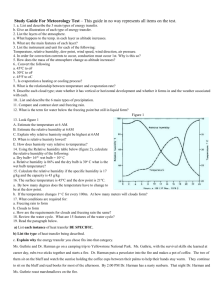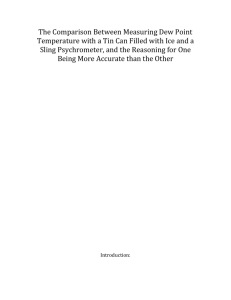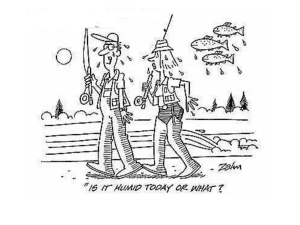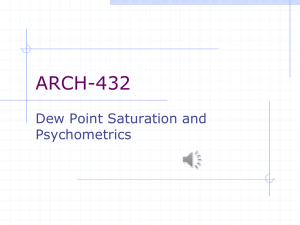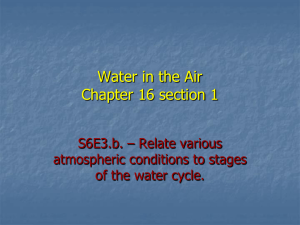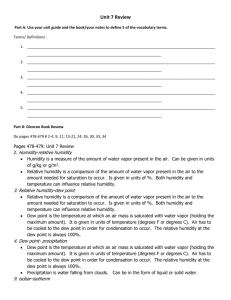Measuring Dewpoint and Relative Humidity
advertisement
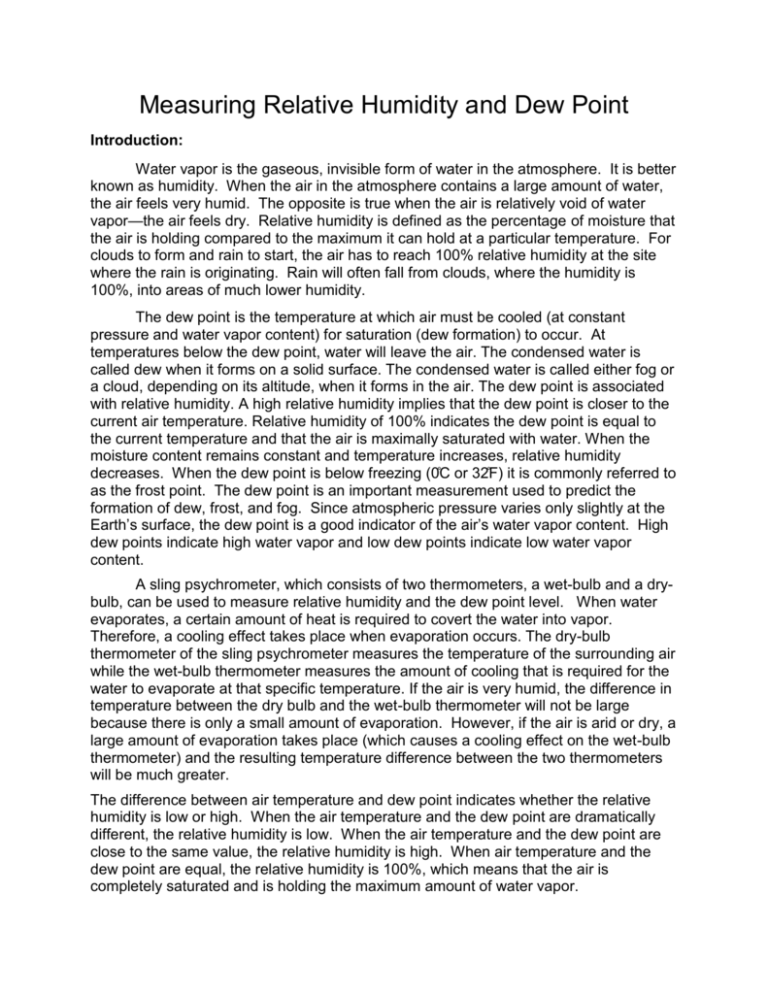
Measuring Relative Humidity and Dew Point Introduction: Water vapor is the gaseous, invisible form of water in the atmosphere. It is better known as humidity. When the air in the atmosphere contains a large amount of water, the air feels very humid. The opposite is true when the air is relatively void of water vapor—the air feels dry. Relative humidity is defined as the percentage of moisture that the air is holding compared to the maximum it can hold at a particular temperature. For clouds to form and rain to start, the air has to reach 100% relative humidity at the site where the rain is originating. Rain will often fall from clouds, where the humidity is 100%, into areas of much lower humidity. The dew point is the temperature at which air must be cooled (at constant pressure and water vapor content) for saturation (dew formation) to occur. At temperatures below the dew point, water will leave the air. The condensed water is called dew when it forms on a solid surface. The condensed water is called either fog or a cloud, depending on its altitude, when it forms in the air. The dew point is associated with relative humidity. A high relative humidity implies that the dew point is closer to the current air temperature. Relative humidity of 100% indicates the dew point is equal to the current temperature and that the air is maximally saturated with water. When the moisture content remains constant and temperature increases, relative humidity decreases. When the dew point is below freezing (0̊C or 32̊F) it is commonly referred to as the frost point. The dew point is an important measurement used to predict the formation of dew, frost, and fog. Since atmospheric pressure varies only slightly at the Earth’s surface, the dew point is a good indicator of the air’s water vapor content. High dew points indicate high water vapor and low dew points indicate low water vapor content. A sling psychrometer, which consists of two thermometers, a wet-bulb and a drybulb, can be used to measure relative humidity and the dew point level. When water evaporates, a certain amount of heat is required to covert the water into vapor. Therefore, a cooling effect takes place when evaporation occurs. The dry-bulb thermometer of the sling psychrometer measures the temperature of the surrounding air while the wet-bulb thermometer measures the amount of cooling that is required for the water to evaporate at that specific temperature. If the air is very humid, the difference in temperature between the dry bulb and the wet-bulb thermometer will not be large because there is only a small amount of evaporation. However, if the air is arid or dry, a large amount of evaporation takes place (which causes a cooling effect on the wet-bulb thermometer) and the resulting temperature difference between the two thermometers will be much greater. The difference between air temperature and dew point indicates whether the relative humidity is low or high. When the air temperature and the dew point are dramatically different, the relative humidity is low. When the air temperature and the dew point are close to the same value, the relative humidity is high. When air temperature and the dew point are equal, the relative humidity is 100%, which means that the air is completely saturated and is holding the maximum amount of water vapor. Material: Metal Can Water at room temp Ice Sling psychrometer Pipet Earth Science Reference Tables pg. 12 Procedure: Part I: Direct Dew Point Measurement 1. Fill the metal can approximately one-half full with room temperature water. 2. Place a thermometer in the water and record the initial temperature (in C ̊ ) in Data Table 1. 3. Slowly add ice to the water and swirl the can gently. As soon as moisture is felt on the outside of the can, note the temperature. This is the dew point temperature. Record the dew point in Data Table 1. 4. If large droplets of water form on the outside of the can before the final temperature is recorded in step 3, the recorded final temperature will not be accurate. If this occurs, empty and dry the can and then repeat the procedure once the can has reached room temperature. Part II: Sling Psychrometer Dew Point Measurement 1. Obtain a pre-assembled psychrometer. 2. Measure the temperature of the air using the dry-bulb thermometer. Record this value in degrees Celsuis in Data Table 2. 3. Use a pipet to place a few drops of water onto the gauze covering the bulb of the wet-bulb thermometer. 4. Hold the plastic handle tightly and slowly rotate the thermometers around the screw. The spinning motion will accelerate the evaporation rate of the water. 5. Spin the thermometers until the temperature of the wet-bulb thermometer drops to a point where it remains constant. 6. After time has elapsed, immediately record the temperature of the wet-bulb thermometer in Data Table 2. Determine the temperature difference between the dry- bulb and the wet-bulb temperature measurements. This is the wet-bulb depression. Record this value in Data Table 2. 7. Using the Dewpoint table on page 12 in your ESRT, determine the Dewpoint and record it in Data Table 2. Part III: Relative Humidity Calculation: Go to: http://ww2010.atmos.uiuc.edu/(Gh)/guides/mtr/cld/dvlp/rh.rxml 3. Calculate the saturation vapor pressure by using equation 2 (assuming standard atmospheric pressure). Record this value in Data Table 3. Equation 2: Saturation vapor pressure = 6.11 X 10 [(7.5 x dry-bulb temperature ̊C)/(237.7 + dry bulb temperature ̊C)] HINT: do the [math] first, then then multiplication. 4. Calculate the actual vapor pressures for Parts I and II using equation 3. Equation 3: Actual vapor pressure = 6.11 X 10 [(7.5 x dew point temperature ̊C)/(237.7 + dew point temperature ̊C)] 5. The relative humidity values for Parts I and II can be calculated using Equation 4. Record these values in Data Table 3. Equation 4: Relative Humidity(%) = (actual vapor pressure/saturation vapor pressure) x 100 (Go to http://www.srh.noaa.gov/epz/?n=wxcalc_vaporpressure to check your calculations for equation 1 and 2) Part IV: Sling Psychrometer Relative Humidity Measurement 1. Determine the temperature on the dry-bulb thermometer. Record the temperature in Data Table 4. 2. Use a pipet to place a few drops of water on the gauze of the wet-bulb thermometer. 3. Hold the plastic handle in your hand and slowly rotate the thermometers around the screw. The spinning motion will accelerate evaporation rate of the water. 4. Spin the thermometers until the temperature of the wet-bulb thermometer drops to a point where it remains constant. 5. After time has elapsed, immediately record the temperature of the wet-bulb thermometer in Data Table 4. Determine the temperature difference between the drybulb and the wet-bulb temperature measurements. This is the wet-bulb depression. Record this value in Data Table 4. 6. Use the Relative Humidity Table (ESRT pg. 12) to determine the relative humidity of the air. Record this value in Data Table 4. Relative Humidity and Dew Point Data Sheet: Recreate these data tables in your lab notebook. Data Table 1: Direct Dew Point Measurement Initial Temperature (̊C) Dew Point Temperature (̊̊C) Data Table 2: Sling Psychrometer Dew Point Measurement Dry Bulb Temperature (̊C) Wet-bulb Temperature (̊C) Wet-bulb Depression (̊C) Dew Point Temperature (̊C) Data Table 3: A. In your lab notebook, define saturation vapor pressure and actual vapor pressure. B. How are these measurements useful in this lab? Dry-bulb Temperature (̊C) Dew Point Temperature from Part I (̊C) Dew Point Temperature from Part II (̊C) Saturation Vapor Pressure (millibars) Actual Vapor Pressure Part 1 (millibars) Actual Vapor Pressure Part II (millibars) Relative Humidity Value from Part I Relative Humidity Value from Part II % % Data Table 4: Sling Psychrometer Relative Humidity Measurement Dry-bulb Temperature (̊C) Wet-Bulb Temperature (̊C) Difference between dry bulb and wet bulb (̊C) Relative Humidity (from ESRT pg 12) Questions: Answer the following questions in your lab notebook. Be sure to restate the questions in your answer. 1. Why is dew point an important measurement in the study of weather? 2. Why is relative humidity an important measurement in the study of weather? 3. What are the relationships between air temperature, dew point and relative humidity? 4. What happens when the air temperature and dew point are equal? What does this mean? 5. How would a greater difference in saturation vapor pressure and actual vapor pressure affect relative humidity? 6. If we went outside to gather our results, how do you think the Dew Point would change? Relative Humidity? Explain your answer. 7. Check out our weather today at www.weather.com . What is the dewpoint? What is the relative humidity? What will happen to relative humidity as the day goes on? Using what you have learned in this lab, explain why this will happen. For questions #8-16, refer to the graph below, which shows the hourly surface temperature, dew point, and relative humidity for a twenty-four hour period during the month of May. 100 90 80 Relative Humidity (%) 70 Air Temp. (F) 60 50 Dew Point Temp. (F) 40 30 12:00 AM 8:00 PM 4:00 PM 12:00 PM 8:00 AM 4:00 AM 12:00 PM 20 8.The lowest air temperature occurred at what time? 9.The highest relative humidity reading occurred at what time? 10The highest air temperature occurred at about what time? 11.The lowest relative humidity occurred at about what time? 12.According to the graph, what happens to the relative humidity as the air temperature increases? 13.At what time(s) did the air temperature equal the dew point? 14.What was the relative humidity (%) when the air temperature equaled the dew point? 15.Condensation (water coming out of the air) is most likely to occur at approximately what time? 16.At approximately what time was the rate of evaporation highest? 17The greatest change in air temperature occurred during the period from: A) midnight to 6AM C) noon to 6PM B) 6AM to noon D) 6PM to midnight More questions on the next page…keep your thinking caps on, geologists! 18. When air temperature is closer to dew point, the precipitation is (most/least) likely to occur. Explain your choice. 19. When air temperature is closer to the wet-bulb temperature, then the relative humidity tends to be (higher/lower). Explain your choice. 20. Given a constant dew point, as temperature rises, relative humidity (rises/falls). Explain your choice. 21. Given a constant dew point, as temperature falls, relative humidity (rises/falls). Explain your choice. 22. When air pressure increases, saturation vapor pressure (increases, decreases, does not change). Explain your choice. 23. When dew point temperature increases, actual vapor pressure (increases, decreases, does not change). Explain your choice. Air Temperature and Dew point temperature for three cities are listed below. Remember air temperature is related to what the humidity must be for the air to become saturated and dew point is the temperature to which the air must be cooled to become saturated. Air temperature is closely related to saturation humidity and dew point is most closely related to actual humidity in the air. Air Temp City A City B City C 40 °C 20 °C 30 °C Dew-point Temp 20 °C 12 °C 17 °C 24. Which city has the largest relative humidity? 25. Which City has the lowest relative humidity? 26. Which city has the greatest amount of water vapor in the air? 27. Which city has the least amount of water vapor in the air?


